
100 North Main is the tallest building in Memphis, Tennessee. At 430 feet, (131m) it has 37 floors and stands bordering Adams Avenue, North Second Street, and North Main. The building is currently totally vacant and closed to public entry. Plans for renovation to convert the building to hotel and apartments have repeatedly failed. The building stands abandoned and fenced off as of May 2016. The building has been condemned by Shelby County Environmental Court since late 2015 when it was discovered that chunks of concrete were falling from the building's exterior walls, as well as the elevators being inoperable and the fire safety systems not being up to code or functional. It was listed on the National Register of Historic Places in 2015.
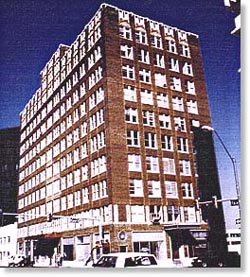
The Dermon Building is a historic building in Memphis, Tennessee, listed on the National Register of Historic Places. It was constructed in 1925 by Dave Dermon at a cost of around $800,000. From the time it was constructed, until 1983, it was the home of Dave Dermon Company, and Dave Dermon Insurance. 'Papa' sold the building in the 1930s, and although it has changed hands many times, it is still known as the Dermon Building today.

The Hu. Hotel is a luxury boutique hotel in Downtown Memphis, Tennessee, United States, located in the historic former Tennessee Trust Bank building.

Alfred Charles Finn was an American architect. He started in the profession with no formal training in 1904 as an apprentice for Sanguinet & Staats. He worked in their offices in Dallas, Fort Worth, and Houston. His credits during his tenure residential structures, but firm was a leader in steel-frame construction of skyscrapers.

Barnett, Haynes & Barnett was a prominent architectural firm based in St. Louis, Missouri. Their credits include many familiar St. Louis landmarks, especially a number related to the local Catholic church. Their best-known building is probably the Cathedral Basilica of St. Louis. A number of the firm's works are listed on the U.S. National Register of Historic Places.
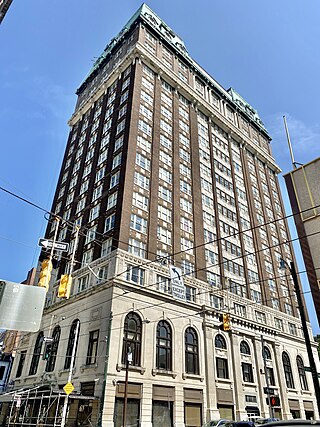
The Exchange Building is a 19-story skyscraper, which was formerly known as the Cotton Exchange Building and the Merchants Exchange Building, and is the twelfth-tallest building in Memphis, Tennessee. It should not be confused with the Memphis Cotton Exchange which is located on Front Street and Union Avenue. The Exchange Building is located at the corner of Second Street and Madison Avenue in downtown Memphis, Tennessee. It is 264.0 feet (80.5 m) tall and has 217,244 square feet (20,182.6 m2) of living space. The building is made of steel and concrete, and employs many decorative elements including Tennessee marble, granite, and detailed plaster work.
Jones & Furbringer was an architectural firm founded in 1904 by the partnership of Walk Claridge Jones, Sr. and Max H. Furbringer. It designed a number of buildings that are listed on the U.S. National Register of Historic Places. The firm eventually was absorbed into brg3s.

McKissack & McKissack is an American design, program management and construction firm based in New York. It is the oldest Black-owned architecture and construction company in the United States.

The D.T. Porter Building in Memphis, Tennessee, was constructed in 1895 and was the city's first steel frame skyscraper. It had a circulating hot water heating system. It was renovated in 1983 and converted to condominiums. It was listed on the National Register of Historic Places for Shelby County, Tennessee, in 1995. It was designed by Edward Culliatt Jones's architecture firm.

The James Lee House, also known as the Harsson-Goyer-Lee House, is a historic house at 690 Adams Avenue in Memphis, Tennessee, United States. It is listed on the National Register of Historic Places, together with the adjacent Woodruff-Fontaine House. The two houses are included in the Victorian Village historic district.
Hanker & Cairns was an architectural firm of Memphis, Tennessee. It was formed in 1903 as a partnership of William Julius Hanker (1876-1958) and Baynard Snowden Cairns (1875-1934).

Scimitar Building, also known as the Memphis Light, Gas, and Water Building, Winchester Building and most recently Hotel Napoleon, is a five-story stone-veneer structure in Memphis, Tennessee. Its architecture features a combination of Beaux-Arts and Romanesque Revival styles. It started life as the home of the Memphis newspaper Evening Scimitar and is currently a boutique hotel.

The Boyce-Gregg House is a historic house in Memphis, Tennessee.

Hotel Claridge is a historic hotel building in Memphis, Tennessee, U.S.. It was built in 1924 for Charles Levy and Morris Corn, two businessmen from St. Louis, Missouri. Its construction cost $1.5 million, and it was designed by the Memphis architectural firm of Jones & Furbringer and the St. Louis firm of Barnett, Haynes & Barnett.
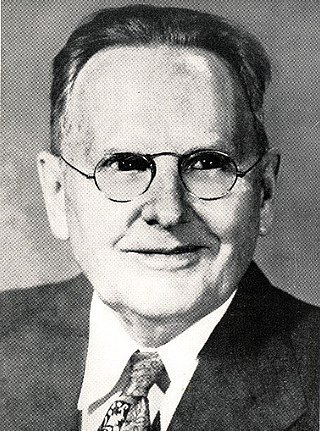
George Awsumb was a prominent Norwegian-American architect in the first half of the 20th century. Awsumb defined architecture as "frozen music" designed for the "man on the street". He was influenced by his early life, European travels, and prevailing architectural trends of his time. His eclectic, progressive portfolio included neoclassical, Gothic Revival, Prairie School, and International Style designs. Several buildings that Awsumb designed have been in continuous use in the American Midwest and South for over 100 years. In particular, Awsumb began a family architectural legacy that contributed to the progress and development of Memphis, Tennessee.
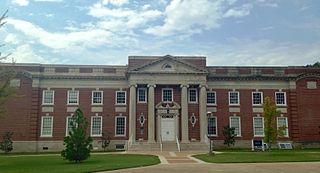
George Mahan Jr. was an American architect based in Memphis, Tennessee. He designed courthouses, many residences, and schools. Many of his designs were Neoclassical architecture style, and several buildings he designed are listed on the National Register of Historic Places (NRHP).
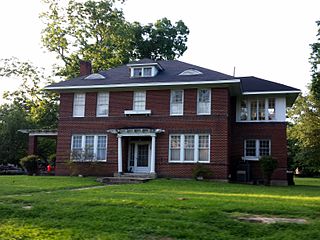
Estes Wilson Mann Sr. was an American architect based in Memphis, Tennessee. Several buildings he designed are listed on the National Register of Historic Places.

Everett Dedman Woods was an architect based in Memphis, Tennessee. He was the younger brother of fellow architect Neander Woods Jr. The Coca-Cola bottling plant he designed in Covington, Tennessee is listed on the National Register of Historic Places and a residence he built in Memphis became corporate headquarters for Harrah's Entertainment. He also designed East High School in Memphis.

Robert Lee Hall was an architect based in Memphis, Tennessee who established the firm of Robert Lee Hall and Associates. He designed Clark Tower in East Memphis, 100 North Main in downtown Memphis, and Patterson Hall at the University of Memphis.

Walk Claridge Jones Sr. was an American architect based in Memphis, Tennessee. He designed buildings listed on the National Register of Historic Places like the First Congregational Church and Parish House and the Pauline Cheek Barton House. He co-founded Jones & Furbringer with Max H. Furbringer, and they designed many more buildings, including the NRHP-listed Hotel Claridge.




















